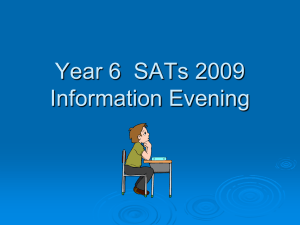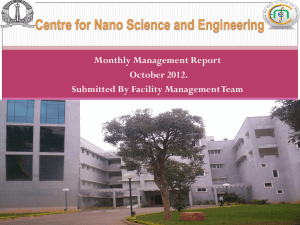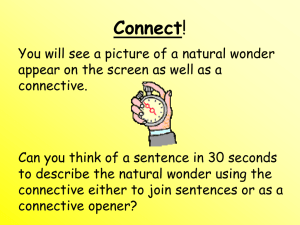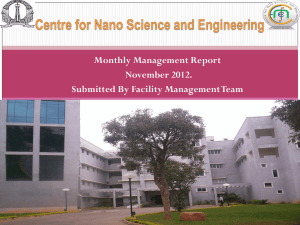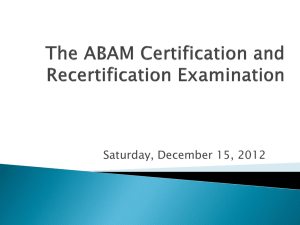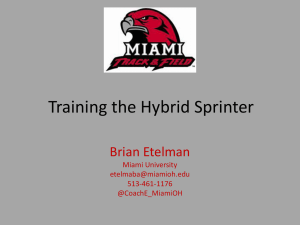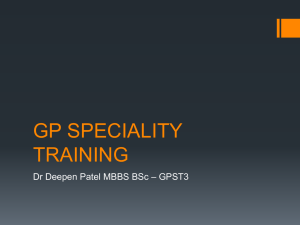Mecklenburg Staffing Model
advertisement
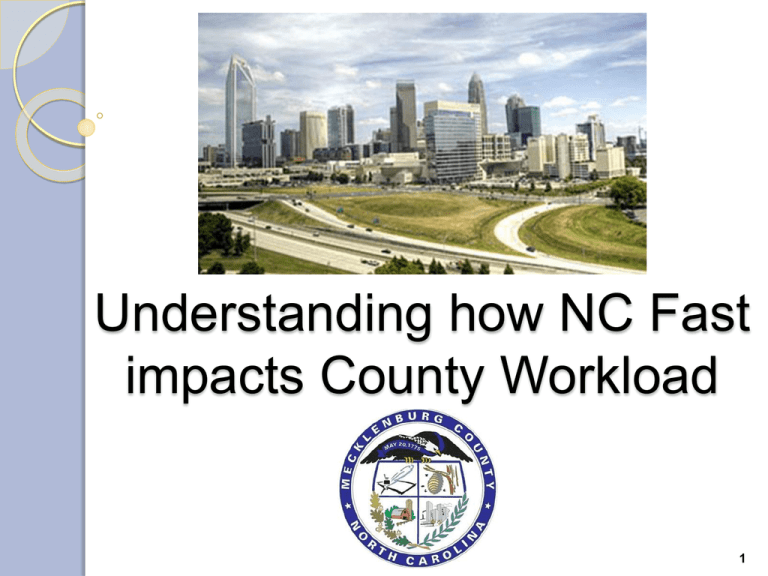
Understanding how NC Fast impacts County Workload 1 Understanding how NC Fast impacts County Workload Timothy Scott Trevor Thomason Business Process Consultant Business Process Consultant Six Sigma Black Belt Six Sigma Green Belt timothy.scott@mecklenburgcountync.gov 704-363-5447 704-591-5007 Mecklenburg County 2 Meeting goals… • Establish time “standards” in NC Fast • Help counties understand how NC Fast impacts their business/budget • Review how counties can measure, track, and analyze the productivity of staff working in NC FAST • Discuss the data we have today • Understand how we captured this information • Are we missing any data • Determine next steps • Review “Capacity Model” 3 Determining Time Standards & Understanding Capacity Phase 1 4 How is NC Fast impacting your county… “NC Fast is slow and processing applications is taking longer...” “Our clients are waiting longer to get their benefits…” “Staff is working more overtime to handle our workload…” “We don’t have enough people in our office to handle the additional work it takes to process a claim…” “My County Commissioners want to understand how this is impacting our ability to serve our citizens…” “How is NC Fast impacting county workload…” How can we take these subjective comments and respond with objective data? 5 Rodney Adam’s, Director ESD, had a business problem… • How is NC Fast impacting our ability to process applications? • How many people do I need on staff for FY 2015 budget? • How many applications can I process with the staff I have? • What service level can be reasonably achieved? …What is the current capacity in Mecklenburg County? 6 • • • • • Be flexible Develop DSS Strategic Plan Partner to develop a “Consolidated Services Model” Increase communication Increase learning and continuous quality We NEED to understand capacity Move from “Reactionary” to “Predictive” …Tactical to Strategic …Random to Balanced …Unanticipated to Planned 8 How can we apply industrial engineering practices to solve this business problem? • Understanding time in business processes… - Touch Time (TT) – How long it takes to complete a task 9 How can we apply industrial engineering practices to solve this business problem? • Understanding time in business processes… - Touch Time (TT) - Wait Time (WT) – Does the process STOP and wait for something to be completed 10 How can we apply industrial engineering practices to solve this business problem? • Understanding time in business processes… - Touch Time (TT) - Wait Time (WT) - Cycle Time (CT) – Overall time for task to be completed 11 How can we apply industrial engineering practices to solve this business problem? • Understanding time in business processes… - Touch Time (TT) - Wait Time (WT) - Cycle Time (CT) Touch Time + Wait Time = Cycle Time 12 How can we apply industrial engineering practices to solve this business problem? • Completed process maps for key activities across DSS… • Identified the major business tasks or “chunks of work” in process maps… - How long does it take to complete the task? - How often does this event happen? - How complex is the task? Consider business culture… 13 Real world example… How much does it cost to replace a muffler on my 2007 Toyota pick-up truck? 14 15 16 How do you establish Time Standards? 1. Understand repair procedure (process map) 2. Conduct time study with a fully trained technician (gather data from case worker) 3. Allow for non-productive time - locating vehicle, pulling into service bay, test-drive after repair… (non-productive time) 4. Establish time standards 17 Complete process map… 18 Identify key tasks… 19 Identify key tasks… Task 1 Task 2 Task 3 Task 6 Task 4 Task 5 20 Considerations for time study tool selection • How long does it take to complete the task – DURATION? (days, hours, minutes, seconds…) • How often does this event happen - FREQUENCY? (yearly, monthly, weekly, daily, hourly…) • How complicated is the business process - COMPLEXITY? (simple, moderate, requires specialization…) • Employee / department differences – VARIATION? (novice, solid performer, expert / job function) • Leader / team attitude – CULTURE? 21 Tool selection and criteria… Tool Duration Frequency Complexity Timed with a stop watch – (observer) Short touch time (TT) Very Repetitive Simple to moderate Self-timed by worker (tracking sheets) Medium to long TT Repetitive to unique Simple to complex Self-work sampling (15 minute increments) Medium to long TT Varied to unique Moderate to complex actions Job shadowing (observer) Any Varied to unique Moderate to complex actions Data extracted from automated system Any Any Any UNDERSTAND Business CULTURE 22 Tool selection and criteria… Tool Duration Frequency Complexity Timed with a stop watch – (observer) Short touch time (TT) Very Repetitive Simple to moderate Self-timed by worker (tracking sheets) Medium to long TT Repetitive to unique Simple to complex Self-work sampling (15 minute increments) Medium to long TT Varied to unique Moderate to complex actions Job shadowing (observer) Any Varied to unique Moderate to complex actions Data extracted from automated system Any Any Any UNDERSTAND Business CULTURE 23 What are the business tasks and factors we should study? • Medicaid programs… • Work First… • Food and Nutrition programs… • Size of County… • Demographic differences… • Representative sample… • Data collection time frame… • Number of study participants… • Tenure of employees… • How you train study participants… Is this data collection model “Repeatable” and “Reproducible” 24 Create tracking tool and train staff on usage… 23 Identify sample size, participants & skill level… Identify skill type across sample population 24 Factors to consider when determining capacity: Employee productivity Number of meetings Vacation, sick days and holidays Training requirements Team building days Overtime considerations Workdays per year (256 days) Employee skill level (Expert, Solid Performer, Novice) Type work done (duration, frequency, complexity, variation, culture) 25 Food and Nutrition Services New Application Processing (Touch Time per Task - Minutes) 114 Minutes of Total “ Average Touch Time” 19 mins ISSI Search and Registration n=40 1 – 50 mins 14 mins 23 mins 16 mins 42 mins NC FAST Search & Registration n=29 Keying Application in NCF & Assigning n=21 Updating ISSI n=50 Processing Application n=37 1– 31 mins 1 – 58 mins 3 – 75 mins 3 – 90 mins Data ranges for each step in FNS Application Processing n = number of samples taken for a specific step 26 Medical Assistance New Application Processing (Touch Time per Task - Minutes) 126 Minutes of Total “Average Touch Time” 10 mins 18 mins ISSI Search and Registration n=40 NC FAST Search & Registration n=45 1 – 31 mins 1 – 97 mins 28 mins Keying Application in NCF & Assigning n=21 1 – 112 mins 15 mins 55 mins Updating ISSI n=50 Processing Application n=37 3 – 51 mins 1 – 228 mins Data ranges for each step in MA Application Processing n = number of samples taken for a specific step 27 Touch Time in MINUTES Food & Nutrituion Changes * Novice n Household Changes Bilingual Income Changes Bilingual Misc. Changes Bilingual Solid n Expert n 28 27 28 38 21 9 15 4 73 3 23.3 20 Solid 32 Income 27 English 28 n 30 n 31 n 63 Expert 28 Misc. 30 n 48 n 23 TOTAL Touch time by skill Touch time by change type Touch time Bilingual vs English OVERALL TOTAL Touch time n (sample size) Novice n Household 34 Bilingual 38 n 24 n 15 30 78 * 1 case incomplete 28 Touch Time in MINUTES Food & Nutrition Re-certifications * Timely Bilingual Untimely Bilingual Late Bilingual Novice n Solid n Expert n 41 55 37 62 42 41 11 4 3 1 36 49 45 50 42 41 44 7 1 12 33 25 33 38 15 6 27 1 Novice 40 Timely 46 Bilingual 47 n 190 n 60 n 74 Solid 49 Untimely 43 English 38 n 21 n 105 n 151 Expert 41 Late 31 n 14 n 60 TOTAL Touch time by Skill Touch time by Recert type Bilingual vs English only OVERALL TOTAL Touch time n (sample size) 41 225 * 17 cases incomplete 29 Method of Application FNS (Interview/Screen/Queue) MA (Interview/Screen/Queue) FNS (Processing) MA (Processing) TOTAL TOTAL M/F/D 5 minutes 5 minutes 115 minutes 115 minutes 120 minutes Face-to-face 45 minutes * 45 minutes * 75 minutes * 75 minutes * 120 minutes * e-PASS 5 minutes * 5 minutes * 115 minutes * 115 minutes * 120 minutes * *Estimates – Time study has not been conducted for these activities Program Screen/Queue Re-Certification Total FNS 5 minutes 40 minutes 45 minutes MA 5 minutes ** 115 minutes ** 120 minutes ** **Based on proposed process to manually close case in EIS and re-key as new streamlined application in NCF. 32 FNS: New Application From start to finish, the average touch time to completely process a New FNS Application should take… 110 – 125 min. (Electronic) 110 – 130 min. (Electronic & paper) 33 FNS: Re-Certification From start to finish, the average touch time to completely process an FNS Re-certification should take… 45 – 55 min. (Electronic) 50 – 60 min. (Electronic & paper) 34 MA: New Application – NON MAGI From start to finish, the average touch time to completely process a New MA Application should take… 130 – 140 min. (Electronic) 130 – 150 min. (Electronic & paper) 35 To Do List: Program Activity / Next Steps FNS Changes Determine times for… 1) Income 2) Household 3) Deductions MA Changes Determine times for… 1) English 2) Bilingual MA Re-Certifications Determine times for… 1) English 2) Bilingual MA Applications (Non-MAGI) Determine times for… 1) Face to face 2) Mail/fax/drop-offs 3) ePASS 4) FFM Transfers Work First Determine time for… 1) Client Application & Assessment 2) Case Management Long Term Care Determine time for… 1) Application process 1) Re-Certification 36 Managing variability in processes… Common Cause Variation & Special Cause Variation It’s important to understand the amount of variability… Reduce the amount of variability; compress the upper and lower control limit 35 Developed a forecasting model 36 Developed a forecasting model Given the application volume stated above, this is the number of staff needed to process claims 37 Disciplined and pragmatic approach to determine capacity 40 Determining Time Standards & Understanding Capacity Phase 2 Capacity Model 41 Demonstration 42 Questions? 43 Understanding how NC Fast impacts County Workload Timothy Scott Trevor Thomason Business Process Consultant Business Process Consultant Six Sigma Black Belt Six Sigma Green Belt timothy.scott@mecklenburgcountync.gov 704-363-5447 704-591-5007 Mecklenburg County 44 Thank you… 45
